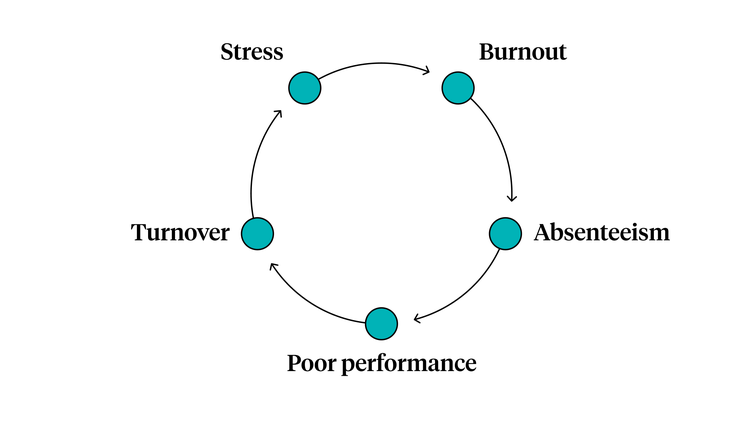
In the past few years, workplace stress has become an epidemic. In fact, the American Psychological Association’s annual Stress in America survey found that between 2019 and 2022, approximately 65% of US workers considered work a very significant or somewhat significant source of stress.
When employees feel stressed at work, it affects their organizations too. Job-related stress is estimated to cost US companies more than $300B in lost productivity and absenteeism each year.
That said, stress isn’t always a bad thing. While too much stress or chronic stress can lead to serious health issues, manageable levels of stress have been shown to increase alertness and performance. April is Stress Awareness Month, and while most people are aware of what stress is, they may not be as familiar with its negative impacts. This article will explore the toll stress can take on individuals and their organizations, what leaders and managers can do to alleviate stress, and why it’s important to prioritize stress management in the workplace.
The causes and effects of workplace stress
Workplace stress is a serious health hazard for employees and a detriment to your bottom line. You want employees to show up engaged, motivated, and determined to achieve their goals. But when your people are suffering from workplace stress, you’ll often see the opposite – fatigue, low productivity, and low morale.
What causes stress at work? It differs from employee to employee, but most stress stems from:
- Poor physical work environment (e.g. inadequate lighting, excessive noise)
- Lack of work/life balance
- Long hours or excessive workload
- Lack of autonomy
- Job insecurity or financial hardship
- Lack of clear leadership
- Lack of communication
- Harassment, misconduct, or other psychosocial risks
A stressed-out employee may not feel confident enough to come forward with how they feel or ask for support, making it more likely that their stress will continue. The employee may start to experience feelings of anxiety, depression, and low morale. They may also have trouble sleeping. Stressed-out employees might present as irritable or short-tempered, which can lead to issues with collaboration in the workplace.
Carrying the burden of this stress home is likely to impact the employee’s personal life. At home, stress can become “contagious” and take a toll on family relationships. This is especially the case for those working remotely where the divide between work and home is less distinct.
Organizational impacts
Widespread workplace stress often leads to burnout, and burnout leads to lower engagement levels and increased turnover.

Stressed employees won’t perform to the best of their ability, and the more stress employees are under, the less equipped they’ll be to help your organization achieve its goals:
- Absenteeism: Stress influences an employee’s presence at work, both physically and mentally. Highly stressed individuals will be more inclined to take time off for doctor’s visits or sick days. Even when stressed employees show up at work, they are more likely to feel detached from the work they’re doing due to the mental strain that stress is placing on them.
- Poor performance: If an employee is struggling to feel connected to their work due to stress, or is physically or mentally absent on a frequent basis, the work they do won’t be as strong. For target-based roles or employees who have OKRs, stress will influence how likely they are to hit those targets. This isn’t ideal for the individual or your company’s financials.
- Turnover and retention: Employees who feel their stress is unmanageable will eventually seek a new role elsewhere, especially if the stress stems from the workplace itself (i.e., physical work setting, poor employee relationships, unreasonable workload). A culture that ignores stress will lead to higher turnover and struggles to retain high performers. Remember, highly engaged employees can still feel stressed or burnt out below the surface.
The role leaders and managers play in reducing stress
It’s normal to occasionally experience stress at work, but as discussed above, prolonged levels of stress can quickly become an issue. According to the World Health Organization (WHO), employees are less likely to experience workplace stress when there’s support from supervisors. Leaders play a critical role in bringing more awareness to stress at work and in reducing stress levels.
Here are 4 ways leaders can help reduce the negative impacts of stress at work:
1. Set an example
Employees are always more likely to follow their managers’ lead. If a leader is working overtime, rarely taking time off, and showing signs of stress – so too will employees. Set an example by encouraging your team to log off at reasonable hours and by only sending emails or communicating during standard work hours. If this isn’t possible (due to dispersed teams, for example), create flexible guidelines. Either way, it’s important to follow the guidelines you’re promoting to your direct reports.
2. Recognize employees
During times of high stress, employees are more likely to grow disengaged if they feel their hard work and output aren’t being acknowledged. Take time to recognize employees who are going above and beyond, and communicate clearly that you appreciate their extra effort. Even if an employee is working to normal levels and not showing signs of stress, make time during 1-on-1s to recognize the work they do on a daily basis. It’ll go a long way.
3. Increase psychological safety
If employees feel their managers can serve as confidantes, they’re more likely to speak up when they’re feeling stressed or if they’re experiencing an issue. Creating safe spaces to express one's emotions and thoughts at work is crucial and can help alleviate any stress before the issue grows more serious. In fact, 89% of employees say it’s essential that leaders foster an environment of psychological safety at work.
4. Help employees own their roles
Stress in the workplace often stems from employees not feeling confident, equipped, or autonomous in their roles. To support your employees, allocate work in line with strengths so they can perform to the best of their ability – and feel pride in their work. If tasks require an employee to step out of their comfort zone, ensure the resources and tools needed to upskill are available. Throwing an employee into the deep end in hopes that they’ll adapt and quickly learn new skills will often lead to feelings of animosity, distrust, and, ultimately, stress.
In contrast, aligning employee work with personal development and growth plans will help employees feel that they’re contributing to larger personal goals. Even during high-stress times, the work will feel more rewarding.
Recognize stress in yourself and others
Reducing stress in the workplace starts with awareness. If you notice that your stress level is high or that your direct reports are showing signs of stress, don’t ignore it. Instead, take steps to mitigate the problem as quickly as possible. Emphasize the importance of employee wellbeing, and create a workplace culture where stress is an occasional challenge, not a daily burden.

Develop a culture of wellbeing
Overcoming stress at work starts with understanding your employees needs.





